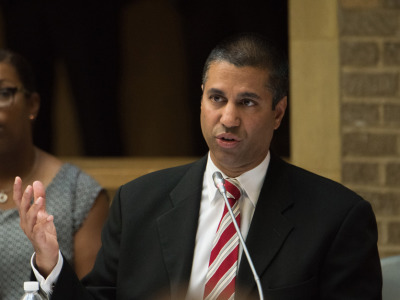The Federal Communications Commission established a $9 billion 5G fund Tuesday to improve mobile wireless access in rural America, with up to $1 billion set aside to improve precision agriculture technology.
According to the FCC, the 5G fund will distribute the money over the next 10 years through multi-round reverse auctions that will take place in two phases.
Phase I will provide $8 billion to areas lacking unsubsidized 4G LTE or 5G mobile broadband. About $680 million will be specifically set aside for bidders offering to serve Tribal lands.
FCC Chairman Ajit Pai and Commissioners Mike O’Reilly and Brendan Carr voted in favor of adopting the order.
Even though the commission won’t immediately conduct the phase one auction for the 5G fund, Pai said it is important those rules are established today.
“First, they provide certainty for stakeholders and provide a clear path to the 5G phase one auction,” he said during the meeting. “Second, we adopt broad public interest obligations that will require carriers currently receiving frozen legacy support, to begin spending that support to deploy 5G capable networks in their service areas beginning next year.”

FCC Chairman Ajit Pai
Phase II will award at least $1 billion, including any unawarded funds in Phase I, to providers who “specifically target the deployment of technologically innovative 5G networks that facilitate precision agriculture.”
Commissioners Geoffrey Starks and Jessica Rosenworcel voted to move forward, but not without expressing concerns.
“We also set aside funds for precision agriculture projects. What data supports the amount selected? How soon will this effort work in concert with the initial phase of 5G support that we commit to today and what facts actually support that budget?” Rosenworcel asked at the meeting.
She argued answers are less than clear because so many of the choices the FCC has made are not grounded in data. While she supports the decision to commit to a wireless future, she said more humility would serve the commission well.
“The framework we have is sound but the details would benefit from more data-gathering before we proceed, so I think this effort needs some work if we want to make sure wireless communities ... truly sees the benefit of 5G wireless,” she said.
In a statement, NTCA – The Rural Broadband Association CEO Shirley Bloomfield said rural consumers and those traveling through rural America will benefit from 5G service.
“(It) promises not only higher speeds but can help empower precision agriculture services for farms and ranches and increased efficiencies for ranching, oil and gas production and sustainable energy production for solar farms, wind farms, and hydraulics,” she said.
Bloomfield also said NTCA looks forward to working with the FCC on creating accurate maps to identify areas eligible for support and the transition of support for small, rural legacy providers.
Commissioners adopted “option B” in the order, which refers to an option in the Notice of Proposed Rulemaking the commission adopted April 23. Pai said this means the phase one auction will begin after FCC develops precise granular broadband maps through its Digital Opportunity Data Collection proceeding.
Interested in more coverage and insights? Receive a free month of Agri-Pulse.
But Pai said in order to start the data collection, the commission needs money from Congress, which he said FCC flagged as a concern almost 500 days ago.
"We are legally prohibited by Congress because of the Broadband Data Act from relying on the only source of funding we had to conduct this operation," he told reporters. The Broadband Data Act requires FCC to use "newly-created maps" when making new awards of broadband funding. "In particular, I believe it was $65 million just for startup costs in the first year alone, which Congress has not given us," Pai said.
FCC said networks must provide 5G mobile broadband at speeds of a least 35/3 Mbps. Requirements also mandate interim deployment milestones beginning at year three and a final deployment milestone at the end of year six.
Pai said the commission should look to the future in that rural areas have an even footing with their urban counterparts for access to 5G.
“These networks will bring rural Americans the benefits like increased accessed to healthcare, education, and precision agriculture that are promised by the improved speed, latency, and security of 5G,” Pai noted.
The Federal Communications Commission also unanimously voted Tuesday to amend its rules governing unlicensed wireless services provided over spectrum in the television broadcasting bands also known as TV white spaces.
According to FCC, the amended rules will allow for the usage of spectrum to delivery broadband services in rural areas and underserved communities.
The Commission notes it also protects broadcast television stations and other licensed services from interference.
Connect Americans Now, a coalition of over 275 organizations and companies from agriculture to healthcare, pushed for FCC to update TVWS rules.
“CAN has been a longtime advocate for updated TVWS rules that will unleash the full potential of this technology as a critical tool to help eliminate the broadband gap,” CAN Executive Director Richard Cullen said in a statement.
FCC also cleared Further Notice of Proposed Rulemaking look into whether or not to modifying its rules to permit the use of terrain-based models to determine available TV channels for white space devices.
For more news, go to www.Agri-Pulse.com.


